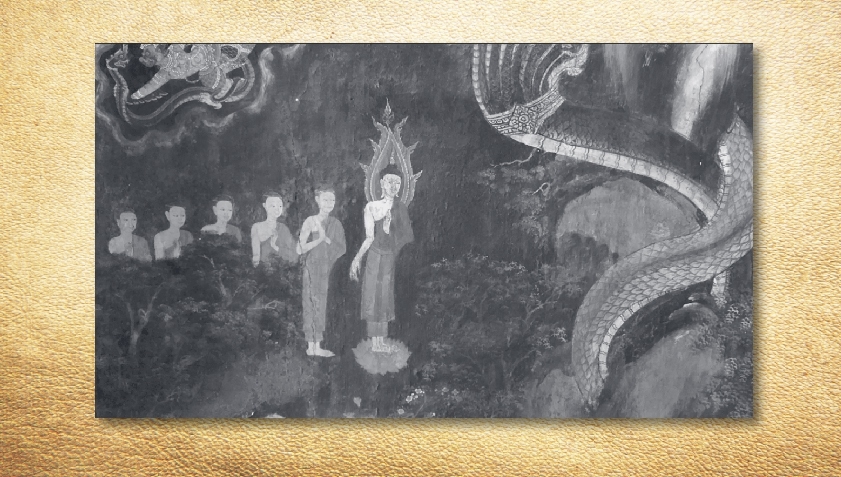
นันโทปนันทสูตรคำหลวง: ความพิเศษ ความหมาย ความเชื่อ แห่งคำเรียกชื่อพญานาค
Nanthopananthasutra Khamluang: Extraordinariness, Meanings and Beliefs of the ‘Great Naga’ Names
โดย ดร.บุญเลิศ วิวรรณ์ / By Dr.Boonlert Wiwan
Damrong Journal, Vol 18, No.1, 2019
บทคัดย่อ:
คำเรียกชื่อ “พญานันโทปนันทนาคราช” จำนวน 48 ชื่อ ซึ่งเกิดจากพระปรีชาสามารถของเจ้าฟ้าธรรมาธิเบศร์ไชยเชษฐ์สุริยวงศ์ (เจ้าฟ้ากุ้ง) ผู้ทรงพระนิพนธ์ “นันโทปนันทสูตรคำ หลวง” ผู้วิจัยพบพระอัจฉริยภาพของผู้สร้างนามหรือคำเรียกชื่อ “พญานันโทปนันทนาคราช” ใน 3 มิติที่สำคัญ คือ 1) มิติด้านคำหลักซึ่งเป็นคำไวพจน์ที่หมายถึง “พญานันโทปนันทนาคราช” พบว่ามี 7 คำสำคัญ คือ 1.1 นิยมใช้คำว่า “นาค” (สัตว์ผู้ประเสริฐ) 1.2 “ผรณราชา” (ผู้เป็นใหญ่ในบรรดาสัตว์ที่แผ่พังพานได้) 1.3 “อุรคะ” (สัตว์ที่ต้องเคลื่อนไหวไปด้วยอก) 1.4 “อาสิวิส” (สัตว์ที่มีพิษบนศีรษะ) 1.5 “สัลปะ” (สัตว์เลื้อยคลานประเภทงู) 1.6 “ทวิชิวหา” (สัตว์ที่มีลิ้น 2 แฉก) 1.7 “ภุชงฺค” (สัตว์ผู้ไปด้วยขนด) มิติที่ 2 คือ มิติด้านการประกอบคำ ผู้วิจัยพบว่ามี 5 ลักษณะ คือ 2.1 ขึ้นต้น “พระญา”+ ลงท้ายด้วยชื่อ “พญานาค” 2.2 ขึ้นต้น “พระยา” + ลงท้ายด้วย “ราชา” 2.3 ขึ้นด้วยชื่อเฉพาะ + ลงท้ายด้วยคำ ว่า “นาค” 2.4 ขึ้นต้นด้วยชื่อเฉพาะ + ลงท้ายด้วย “ราชา” 2.5 ขึ้นต้นด้วยชื่อเฉพาะ + ลงท้ายด้วย “บาดาล” มิติที่ 3 คือมิติด้านความหมายของคำ เรียกชื่อ “พญานันโทปนันทนาคราช” ที่สะท้อนความเชื่อหรือทัศนคติเกี่ยวกับพญานาคในสมัยกรุงศรีอยุธยา โดยผู้วิจัยพบว่ามี 4 ลักษณะ คือ 3.1 ความเป็นผู้ยิ่งใหญ่ 3.2 ความเป็นสัตว์ที่มีลิ้น 2 แฉก 3.3 ความเป็นพระราชาแห่งนาค 3.4 ความเป็นใหญ่ในภพบาดาล
ABSTRACT:
This study investigated the varieties of terms referred to ‘Phaya Nanthopananthanakaracha’. Forty-eight references have been found in this study reflecting the intellectual competence of Prince Dharmathibes Chaiyachet Suriyawong (Chaofah Kung), the author of “Nanthopananthasutra Khamluang.” Furthermore, the results revealed the author had the intellectual capability to produce the names of ‘Phaya Nanthopanantha Nakaracha’ using 3 methods. The first method was the synonyms of ‘Phaya Nanthopanantha Nakaracha’, 7 keywords were found, “Naga” (the great animal) was commonly used, “Pharanaracha” (the great of a serpent), “Uraka” (the animal that moves with chest), “Asiwisa” (the animal with venomous head), “Salapa” (the serpent), “Thawichiwha” (the animal with forked tongue), “Phuchangka” (the coiled animal). The second method was the compounding technique of the great Naga names. Five compounding techniques were found: beginning with “Phraya” and ending with the name of great Naga, beginning with the word “Phraya” and ending with the word “Racha.”, beginning with specific names and ending with the word “Naga.”, beginning with specific names and ending with the word “Racha.”, beginning with specific names and ending with the word “Badan.” The third method was the meaning of ‘Phaya Nanthopanantha Nakaracha’ which reflected beliefs and concepts about the great Naga in the Ayutthaya period. Four types of meanings were found: the greatness, the animal with forked tongue, the beast, and the ownership of netherworld (the world of water).











